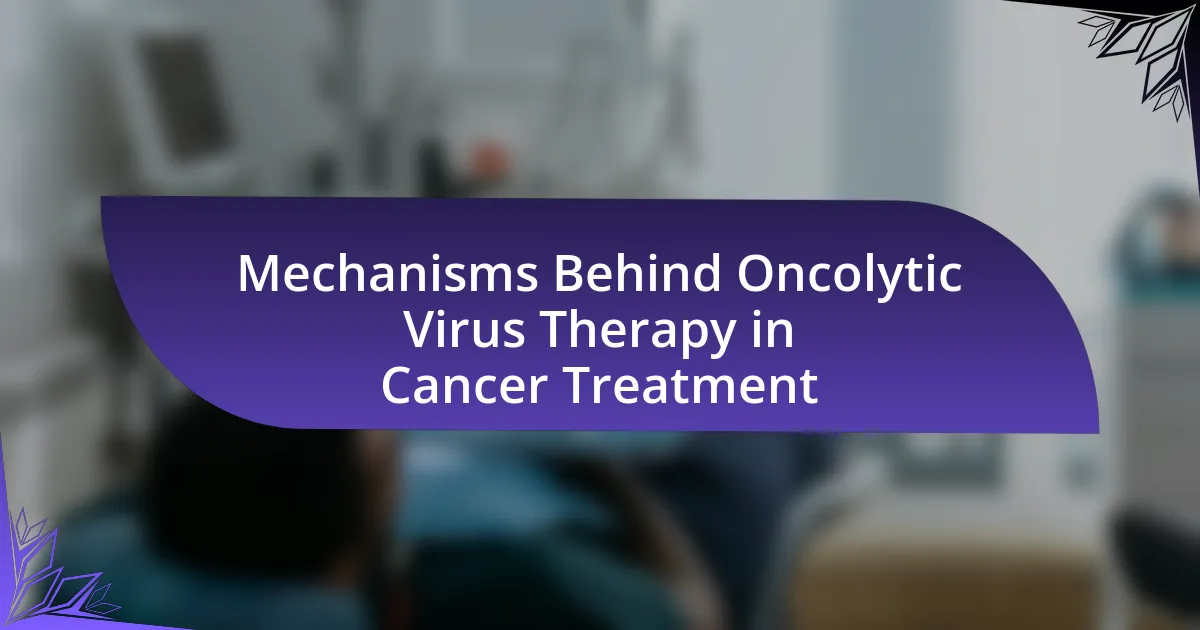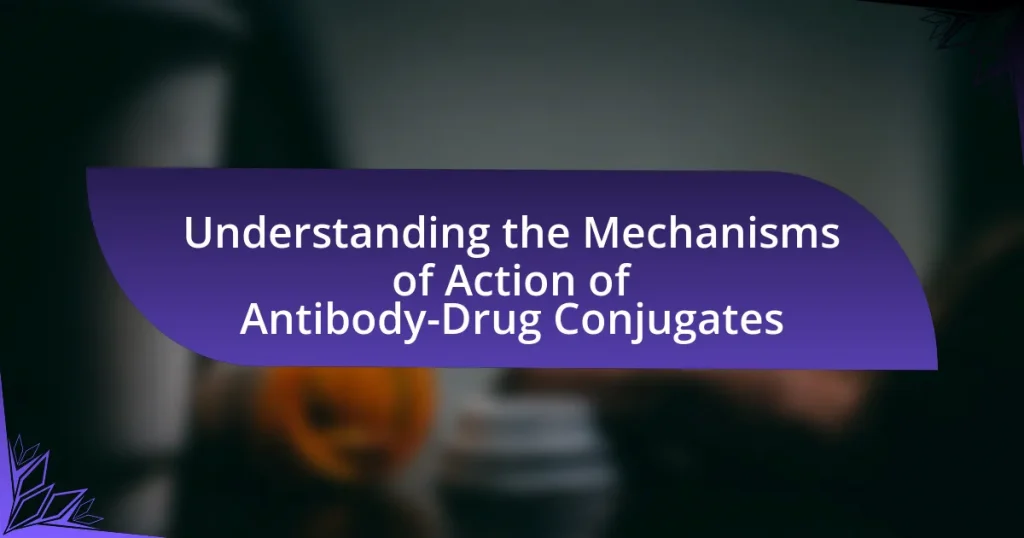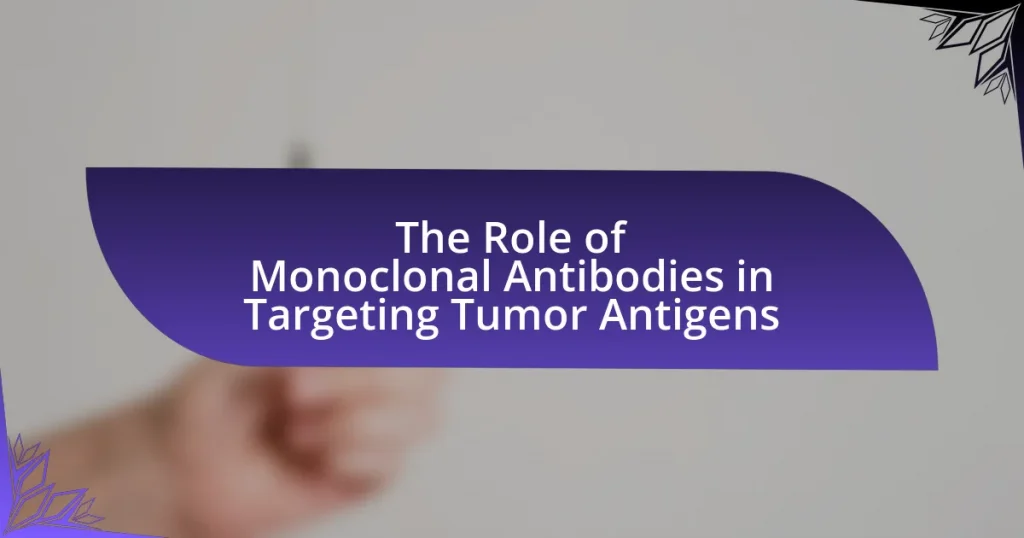Oncolytic virus therapy is an innovative cancer treatment that employs genetically modified viruses to selectively infect and destroy cancer cells while preserving healthy tissues. This therapy operates through mechanisms such as direct oncolysis, immune response induction, and systemic anti-tumor effects. The article explores how oncolytic viruses target cancer cells by exploiting their unique characteristics, the role of the immune system in enhancing treatment efficacy, and the various types of oncolytic viruses utilized in clinical settings. Additionally, it addresses the benefits and challenges of this therapy, ongoing clinical trials, and best practices for patient selection and monitoring during treatment.
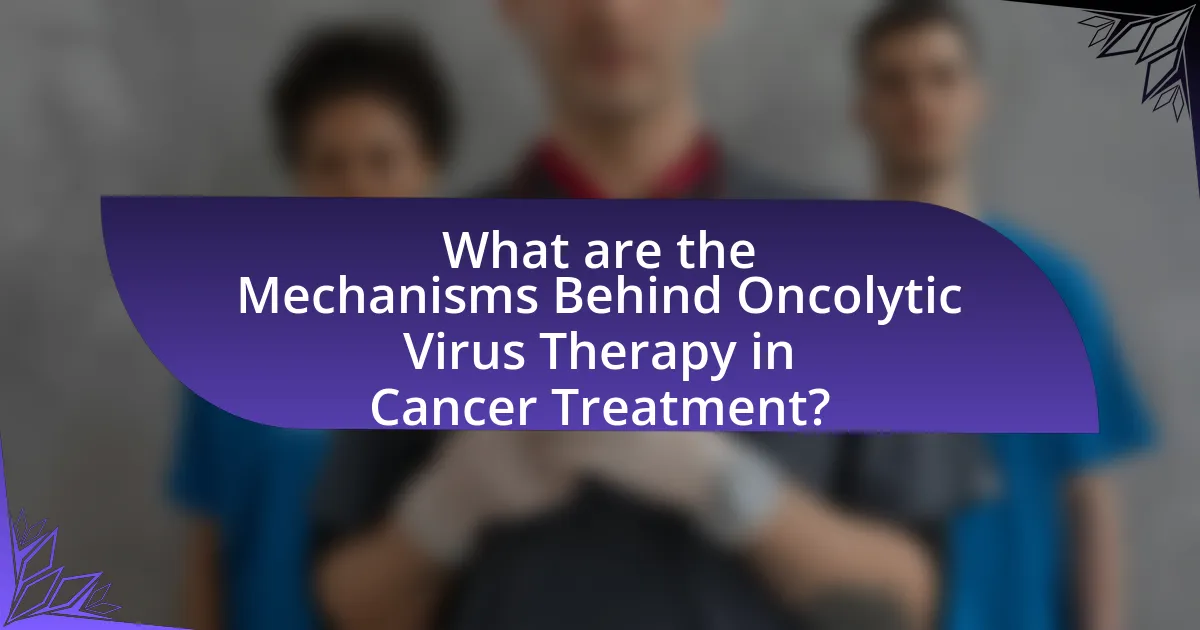
What are the Mechanisms Behind Oncolytic Virus Therapy in Cancer Treatment?
Oncolytic virus therapy utilizes genetically modified viruses to selectively infect and kill cancer cells while sparing normal cells. This therapeutic approach operates through several mechanisms: direct oncolysis, where the virus replicates within and destroys cancer cells; induction of an immune response, which activates the host’s immune system to recognize and attack tumor cells; and the potential for systemic anti-tumor effects, as the immune response can target metastases. Studies have shown that oncolytic viruses can stimulate the production of cytokines and other immune mediators, enhancing the overall anti-tumor immunity. For instance, research published in “Nature Reviews Cancer” by Melcher et al. (2011) highlights how oncolytic viruses can provoke a robust immune response that contributes to tumor regression.
How do oncolytic viruses selectively target cancer cells?
Oncolytic viruses selectively target cancer cells primarily due to the unique characteristics of these cells, such as altered signaling pathways and the presence of specific receptors. Cancer cells often have defects in their antiviral defense mechanisms, making them more susceptible to viral infection. For instance, many oncolytic viruses exploit the overexpression of certain receptors, like the CD46 receptor in some tumors, which facilitates viral entry. Additionally, the tumor microenvironment, which is often hypoxic and immunosuppressive, can further enhance the replication of oncolytic viruses specifically within cancerous tissues while sparing normal cells. This selective targeting is supported by studies demonstrating that oncolytic viruses can replicate more efficiently in cancer cells compared to healthy cells, leading to tumor lysis and subsequent immune activation against the tumor.
What characteristics of cancer cells make them susceptible to oncolytic viruses?
Cancer cells exhibit several characteristics that make them susceptible to oncolytic viruses, primarily their altered signaling pathways and immune evasion mechanisms. These cells often have dysregulated growth factor signaling, leading to increased proliferation and survival, which can be exploited by oncolytic viruses that preferentially replicate in rapidly dividing cells. Additionally, cancer cells frequently downregulate major histocompatibility complex (MHC) molecules, impairing their ability to present antigens and evade immune detection, allowing oncolytic viruses to infect and lyse these cells more effectively. Furthermore, the tumor microenvironment often provides a permissive setting for viral replication due to factors like hypoxia and nutrient deprivation, which are less favorable for normal cells. These characteristics collectively enhance the efficacy of oncolytic virus therapy in targeting and destroying cancer cells.
How do oncolytic viruses differentiate between healthy and cancerous cells?
Oncolytic viruses differentiate between healthy and cancerous cells primarily through the presence of specific receptors and the unique characteristics of the tumor microenvironment. Cancer cells often express altered surface proteins and receptors, such as the overexpression of certain integrins or the presence of specific glycoproteins, which can be recognized by oncolytic viruses, allowing for selective binding and entry. Additionally, the immunosuppressive environment of tumors can facilitate viral replication, as cancer cells may lack the antiviral defenses present in healthy cells, enabling the virus to thrive and induce cell lysis specifically in malignant cells. This selective targeting is supported by studies showing that oncolytic viruses can preferentially infect and kill cancer cells while sparing normal tissues, as evidenced by research published in journals like “Nature Reviews Cancer,” which highlights the mechanisms of viral selectivity in tumor targeting.
What role do the immune system and oncolytic viruses play in cancer treatment?
The immune system and oncolytic viruses play a crucial role in cancer treatment by enhancing the body’s ability to recognize and destroy cancer cells. Oncolytic viruses selectively infect and kill tumor cells while stimulating an immune response against the tumor. This dual action not only leads to direct tumor lysis but also promotes the activation of immune cells, such as T cells and natural killer cells, which can target and eliminate residual cancer cells. Studies have shown that oncolytic virus therapy can increase the expression of tumor antigens, making cancer cells more visible to the immune system, thereby improving overall treatment efficacy. For instance, research published in “Nature” by Melcher et al. (2011) demonstrated that oncolytic viruses can induce systemic anti-tumor immunity, leading to the regression of untreated tumors in animal models.
How do oncolytic viruses stimulate an immune response against tumors?
Oncolytic viruses stimulate an immune response against tumors by selectively infecting and destroying cancer cells while simultaneously activating the host’s immune system. When oncolytic viruses replicate within tumor cells, they cause cell lysis, which releases tumor-associated antigens and danger signals that alert the immune system. This process enhances the recognition of cancer cells by immune cells, particularly dendritic cells, which then present the antigens to T cells, leading to a systemic anti-tumor immune response. Studies have shown that oncolytic viruses can increase the infiltration of immune effector cells, such as cytotoxic T lymphocytes, into the tumor microenvironment, further promoting tumor regression.
What are the mechanisms of immune evasion by tumors in the context of oncolytic virus therapy?
Tumors employ several mechanisms of immune evasion that can hinder the effectiveness of oncolytic virus therapy. These mechanisms include the downregulation of major histocompatibility complex (MHC) molecules, which impairs the recognition of tumor cells by cytotoxic T lymphocytes. Additionally, tumors can secrete immunosuppressive factors, such as transforming growth factor-beta (TGF-β) and interleukin-10 (IL-10), which inhibit immune cell activation and function. Furthermore, the presence of regulatory T cells (Tregs) within the tumor microenvironment can suppress anti-tumor immune responses. Research has shown that these immune evasion strategies can significantly reduce the therapeutic efficacy of oncolytic viruses, as they rely on the host immune system to enhance tumor lysis and promote anti-tumor immunity.
What are the different types of oncolytic viruses used in therapy?
Oncolytic viruses used in therapy include adenoviruses, herpes simplex viruses, vesicular stomatitis viruses, and reoviruses. Adenoviruses are engineered to selectively infect and kill cancer cells while sparing normal cells, as demonstrated in clinical trials showing tumor regression. Herpes simplex viruses have been modified to enhance their oncolytic properties, with studies indicating significant efficacy in treating melanoma. Vesicular stomatitis viruses can induce strong immune responses against tumors, supported by research highlighting their ability to infect and destroy cancer cells. Reoviruses exploit the abnormal signaling pathways in cancer cells, with evidence from trials showing their potential in treating various malignancies.
What are the most common viral vectors utilized in oncolytic virus therapy?
The most common viral vectors utilized in oncolytic virus therapy include adenoviruses, herpes simplex viruses, and vesicular stomatitis viruses. Adenoviruses are frequently used due to their ability to infect a wide range of human cells and their safety profile in clinical applications. Herpes simplex viruses are also prominent because they can selectively replicate in tumor cells while sparing normal tissues, enhancing their therapeutic potential. Vesicular stomatitis viruses are notable for their ability to induce strong immune responses against tumors. These viral vectors have been extensively studied and demonstrated efficacy in various clinical trials, supporting their role in oncolytic virus therapy.
How do genetically modified oncolytic viruses enhance therapeutic efficacy?
Genetically modified oncolytic viruses enhance therapeutic efficacy by selectively targeting and destroying cancer cells while sparing normal tissues. These viruses are engineered to improve their ability to replicate within tumor cells, leading to increased oncolysis, or cancer cell death. For instance, modifications can include the insertion of genes that promote viral replication specifically in malignant cells or the deletion of genes that would allow the virus to infect healthy cells. Research has shown that oncolytic viruses can also stimulate an anti-tumor immune response, further enhancing their therapeutic effects. A study published in “Nature” by Andtbacka et al. (2015) demonstrated that the oncolytic virus talimogene laherparepvec (T-VEC) not only directly lyses tumor cells but also activates systemic immune responses against the tumor, leading to improved patient outcomes in melanoma.
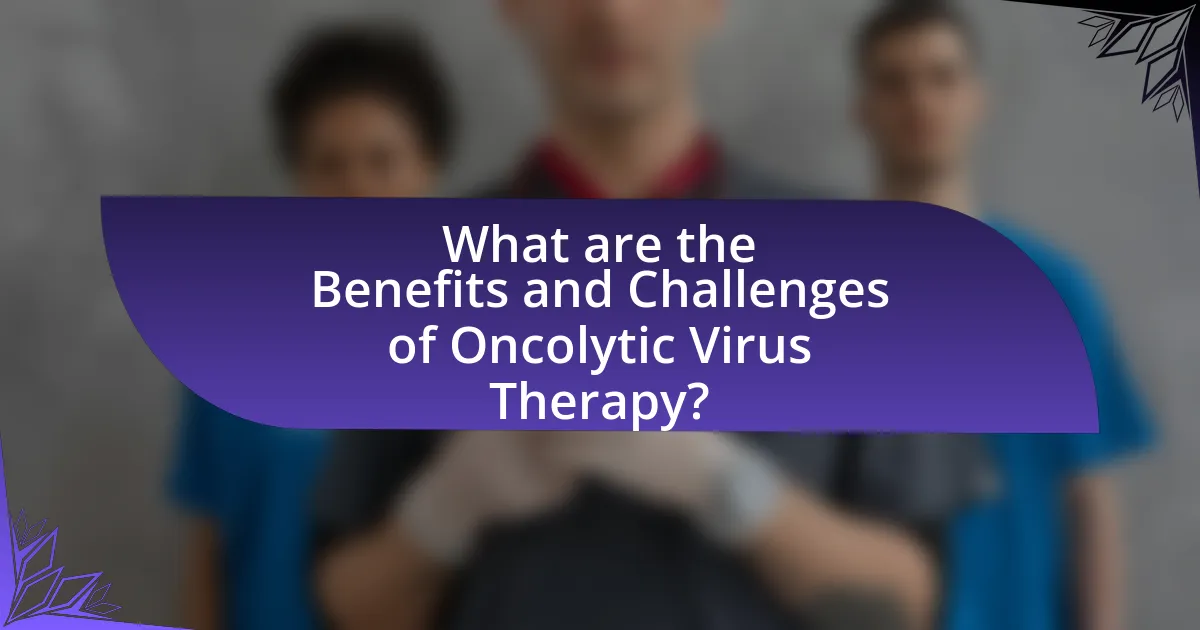
What are the Benefits and Challenges of Oncolytic Virus Therapy?
Oncolytic virus therapy offers significant benefits, including the selective targeting and destruction of cancer cells while sparing normal tissues, which can lead to reduced side effects compared to traditional therapies. This approach harnesses the ability of certain viruses to replicate within and kill tumor cells, stimulating an immune response that can further attack cancer. For instance, studies have shown that oncolytic viruses like Talimogene laherparepvec (T-VEC) can lead to durable responses in melanoma patients, with a reported overall response rate of 26.4% in clinical trials.
However, challenges exist, such as the potential for pre-existing immunity against the oncolytic virus, which can limit its effectiveness. Additionally, the delivery of the virus to tumors can be hindered by the tumor microenvironment, which may restrict viral spread and replication. Research indicates that these challenges can impact the overall efficacy of oncolytic virus therapy, necessitating ongoing studies to optimize treatment protocols and enhance patient outcomes.
What advantages does oncolytic virus therapy offer compared to traditional cancer treatments?
Oncolytic virus therapy offers several advantages over traditional cancer treatments, including targeted tumor destruction, reduced side effects, and the ability to stimulate a systemic immune response. Unlike conventional therapies such as chemotherapy and radiation, which can harm healthy cells and cause significant side effects, oncolytic viruses selectively infect and kill cancer cells while sparing normal tissues. This selectivity minimizes collateral damage and enhances patient tolerance. Additionally, oncolytic viruses can activate the immune system to recognize and attack not only the infected tumor cells but also distant metastases, potentially leading to a more comprehensive anti-cancer effect. Studies have shown that oncolytic virus therapy can lead to durable responses in patients with advanced cancers, highlighting its potential as a powerful alternative or complement to traditional treatments.
How does oncolytic virus therapy improve patient outcomes?
Oncolytic virus therapy improves patient outcomes by selectively targeting and destroying cancer cells while sparing normal tissues. This selective cytotoxicity occurs because oncolytic viruses replicate within and kill tumor cells, leading to tumor lysis and the release of tumor antigens. The released antigens can stimulate a systemic immune response, enhancing the body’s ability to recognize and attack remaining cancer cells. Clinical studies, such as those published in the Journal of Clinical Oncology, have shown that patients treated with oncolytic viruses like talimogene laherparepvec (T-VEC) exhibit improved overall survival rates and tumor response compared to standard therapies.
What are the potential side effects associated with oncolytic virus therapy?
Oncolytic virus therapy can lead to several potential side effects, including flu-like symptoms, fatigue, fever, and localized pain at the injection site. These side effects occur as the immune system responds to the viral infection and the subsequent destruction of cancer cells. Clinical studies have reported that approximately 30-50% of patients experience mild to moderate flu-like symptoms, which typically resolve within a few days. Additionally, some patients may experience more severe reactions, such as inflammation or immune-related adverse events, although these are less common. The overall safety profile of oncolytic virus therapy is generally favorable, with serious side effects occurring in a minority of cases.
What challenges are faced in the clinical application of oncolytic virus therapy?
The clinical application of oncolytic virus therapy faces several challenges, including the need for precise targeting of tumor cells, potential immune responses against the virus, and variability in patient responses. Precise targeting is crucial because non-specific viral replication can harm healthy tissues, leading to adverse effects. Additionally, the immune system may recognize and eliminate the oncolytic virus before it can effectively target the tumor, limiting its therapeutic efficacy. Variability in patient responses arises from differences in tumor microenvironments and genetic factors, which can affect how tumors respond to viral therapy. These challenges highlight the complexity of effectively implementing oncolytic virus therapy in clinical settings.
How do regulatory hurdles impact the development of oncolytic virus therapies?
Regulatory hurdles significantly delay the development of oncolytic virus therapies by imposing stringent requirements for safety and efficacy. These regulations often necessitate extensive preclinical and clinical trials, which can prolong the timeline for bringing therapies to market. For instance, the U.S. Food and Drug Administration (FDA) requires comprehensive data on the biological activity and potential side effects of oncolytic viruses before granting approval, leading to increased costs and resource allocation for developers. Additionally, the complexity of demonstrating the unique mechanisms of action of oncolytic viruses, such as selective targeting of cancer cells while sparing normal tissues, adds further challenges in meeting regulatory standards. This regulatory landscape can hinder innovation and limit patient access to potentially life-saving treatments.
What are the limitations of current research in oncolytic virus therapy?
Current research in oncolytic virus therapy faces several limitations, including issues related to tumor heterogeneity, immune response variability, and delivery challenges. Tumor heterogeneity can lead to differential responses to therapy, as not all cancer cells may be susceptible to the oncolytic viruses. Additionally, the immune system’s response can vary significantly among patients, potentially neutralizing the therapeutic effects of the viruses before they can effectively target the tumor. Furthermore, effective delivery of oncolytic viruses to the tumor site remains a challenge, as barriers such as the extracellular matrix and blood supply can hinder the spread and efficacy of the treatment. These limitations highlight the need for further research to optimize oncolytic virus therapy for diverse cancer types and patient populations.
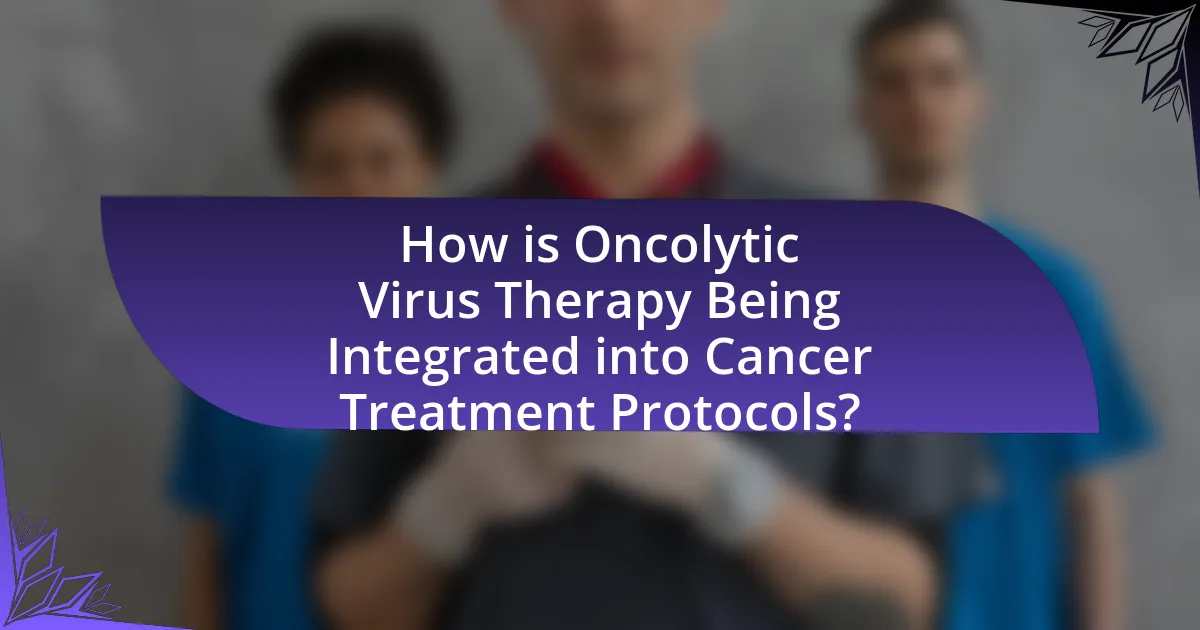
How is Oncolytic Virus Therapy Being Integrated into Cancer Treatment Protocols?
Oncolytic virus therapy is being integrated into cancer treatment protocols through combination strategies with traditional therapies such as chemotherapy and immunotherapy. This integration aims to enhance the overall efficacy of cancer treatment by leveraging the ability of oncolytic viruses to selectively infect and kill cancer cells while simultaneously stimulating an immune response against tumors. Clinical trials, such as those conducted by the National Cancer Institute, have demonstrated that combining oncolytic viruses with immune checkpoint inhibitors can lead to improved patient outcomes, as evidenced by increased tumor regression rates and prolonged survival in various cancer types.
What are the current clinical trials investigating oncolytic virus therapy?
Current clinical trials investigating oncolytic virus therapy include studies evaluating the efficacy of various oncolytic viruses, such as talimogene laherparepvec (T-VEC) and adenovirus-based therapies, in treating different cancer types. For instance, a Phase III trial is assessing T-VEC in combination with immune checkpoint inhibitors for melanoma patients, while another trial is exploring an adenovirus therapy targeting pancreatic cancer. These trials aim to determine the safety, optimal dosing, and overall effectiveness of oncolytic virus therapies in enhancing anti-tumor immune responses.
What types of cancers are being targeted in ongoing clinical studies?
Ongoing clinical studies are targeting various types of cancers, including melanoma, glioblastoma, pancreatic cancer, and breast cancer. These cancers are selected due to their aggressive nature and limited treatment options. For instance, melanoma has shown responsiveness to oncolytic virus therapy, as evidenced by studies demonstrating improved survival rates in patients receiving such treatments. Additionally, glioblastoma, known for its poor prognosis, is being investigated in multiple trials to assess the efficacy of oncolytic viruses in tumor reduction.
How do combination therapies enhance the effectiveness of oncolytic virus treatment?
Combination therapies enhance the effectiveness of oncolytic virus treatment by synergistically increasing tumor cell lysis and improving immune response. When oncolytic viruses are combined with other therapies, such as immune checkpoint inhibitors or chemotherapy, they can create a more hostile environment for cancer cells, leading to enhanced viral replication and spread within tumors. For instance, studies have shown that combining oncolytic viruses with immune checkpoint inhibitors can significantly boost the activation of T cells, which are crucial for targeting and destroying cancer cells. This synergistic effect not only increases the direct cytotoxicity of the virus but also promotes a systemic anti-tumor immune response, thereby improving overall treatment efficacy.
What best practices should be followed when considering oncolytic virus therapy?
When considering oncolytic virus therapy, best practices include thorough patient selection, careful monitoring of immune responses, and adherence to regulatory guidelines. Patient selection should focus on individuals with tumors that are susceptible to viral infection and those who have not responded to conventional therapies. Monitoring immune responses is crucial, as the efficacy of oncolytic viruses often relies on the host’s immune system to recognize and attack cancer cells. Adhering to regulatory guidelines ensures that the therapy is safe and effective, as demonstrated by clinical trials that have shown improved outcomes in specific cancer types, such as melanoma and glioblastoma.
How can healthcare providers assess patient eligibility for oncolytic virus therapy?
Healthcare providers can assess patient eligibility for oncolytic virus therapy by evaluating specific clinical criteria, including tumor type, stage, and the patient’s overall health status. Oncolytic virus therapy is primarily indicated for certain cancers, such as melanoma and glioblastoma, where the tumor microenvironment can support viral replication and tumor lysis. Additionally, providers must consider the patient’s immune status, as a robust immune response can enhance the efficacy of the therapy. Clinical trials and guidelines from organizations like the American Society of Clinical Oncology provide evidence-based criteria for eligibility, ensuring that patients selected for this innovative treatment have the potential for optimal outcomes.
What monitoring strategies are essential during oncolytic virus treatment?
Essential monitoring strategies during oncolytic virus treatment include assessing viral replication, evaluating tumor response, and monitoring patient safety through adverse event reporting. Viral replication can be tracked using quantitative PCR to measure viral load in the tumor and peripheral blood, ensuring the virus is effectively targeting cancer cells. Tumor response is typically evaluated through imaging techniques such as MRI or CT scans, which provide insights into tumor size and metabolic activity. Additionally, monitoring patient safety involves regular blood tests and clinical assessments to identify any adverse effects, which is crucial for adjusting treatment protocols and ensuring patient well-being. These strategies are supported by clinical studies demonstrating the importance of monitoring in optimizing treatment outcomes and minimizing risks associated with oncolytic virus therapies.
